The Cambridge History of Japan, Vol. 1: Ancient Japan
Подождите немного. Документ загружается.

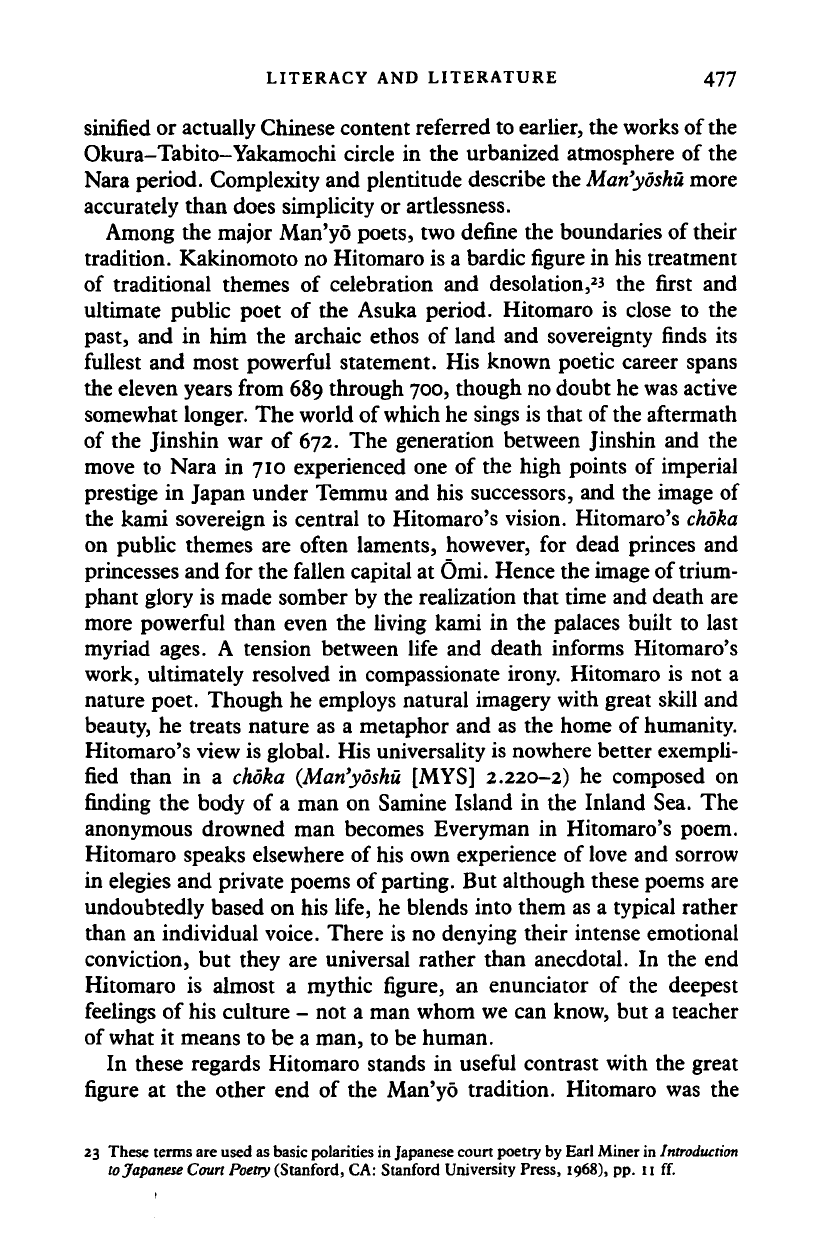
LITERACY AND LITERATURE 477
sinified or actually Chinese content referred to earlier, the works of the
Okura-Tabito-Yakamochi circle in the urbanized atmosphere of the
Nara period. Complexity and plentitude describe the
Man'yoshu
more
accurately than does simplicity or artlessness.
Among the major Man'yo poets, two define the boundaries of their
tradition. Kakinomoto no Hitomaro is a bardic figure in his treatment
of traditional themes of celebration and desolation,
2
* the first and
ultimate public poet of the Asuka period. Hitomaro is close to the
past, and in him the archaic ethos of land and sovereignty finds its
fullest and most powerful statement. His known poetic career spans
the eleven years from 689 through 700, though no doubt he was active
somewhat longer. The world of which he sings is that of the aftermath
of the Jinshin war of 672. The generation between Jinshin and the
move to Nara in 710 experienced one of the high points of imperial
prestige in Japan under Temmu and his successors, and the image of
the kami sovereign is central to Hitomaro's vision. Hitomaro's
choka
on public themes are often laments, however, for dead princes and
princesses and for the fallen capital at Omi. Hence the image of trium-
phant glory is made somber by the realization that time and death are
more powerful than even the living kami in the palaces built to last
myriad ages. A tension between life and death informs Hitomaro's
work, ultimately resolved in compassionate irony. Hitomaro is not a
nature poet. Though he employs natural imagery with great skill and
beauty, he treats nature as a metaphor and as the home of humanity.
Hitomaro's view is global. His universality is nowhere better exempli-
fied than in a choka (Man'yoshu [MYS] 2.220-2) he composed on
finding the body of a man on Samine Island in the Inland Sea. The
anonymous drowned man becomes Everyman in Hitomaro's poem.
Hitomaro speaks elsewhere of his own experience of love and sorrow
in elegies and private poems of
parting.
But although these poems are
undoubtedly based on his life, he blends into them as a typical rather
than an individual voice. There is no denying their intense emotional
conviction, but they are universal rather than anecdotal. In the end
Hitomaro is almost a mythic figure, an enunciator of the deepest
feelings of his culture - not a man whom we can know, but a teacher
of what it means to be a man, to be human.
In these regards Hitomaro stands in useful contrast with the great
figure at the other end of the Man'yo tradition. Hitomaro was the
23 These terms are used as basic polarities in Japanese court poetry by Earl Miner in
Introduction
to Japanese Court Poetry (Stanford, CA: Stanford University Press, 1968), pp. 11 ff.
Cambridge Histories Online © Cambridge University Press, 2008

478 ASUKA AND NARA CULTURE
creator of the grand
choka
manner, and later poets learned from and
emulated his style. Among the many who did so was Otomo no Yaka-
mochi, the putative compiler of the
Man'yoshu
itself,
or at least of large
parts of it. Yakamochi was born after the days of Hitomaro, after the
foundation of the capital at Nara. He was a man of Nara and the scion
of
a
proud and ancient family, one with a strong literary tradition from
his father's day. Yakamochi was a man of literature, a man of the
written word. He looked out on what seems a modern instead of a
mythic world. Preserved through his own efforts, his many waka,
kanshi, and kambun letters allow us to see a person passionate about
poetry, his family honor, and his favorite hawk and ardent in his
pursuit of a number of women. We also see him as host at official
banquets and as friend of his cousin Ikenushi. Yakamochi is moody,
many faceted: an individual, a modern man. He suffered from a spe-
cific and situational anxiety over his political career. It is possible to
know him, or to feel that one does, in a way that is totally out of the
question with Hitomaro. Thus in the simplest terms Hitomaro and
Yakamochi stand for the old and the new in an age of rapid transition.
Yakamochi was aware of the past in a modern way. He looked back
on it as a time of lost virtue and glory. The virtue that he particularly
cherished and that he wished to revive in his own day was
masuraoburi,
the manliness of the warrior. He belonged to an ancient warrior family
that was losing its way in a complex and no-longer heroic modern
world. Yakamochi's idealization of the past as a time of sturdy and
simple loyalty is the counterpart of his anxiety over the present and
future. These attitudes give his work a restlessness and a melancholy
that are alien to Hitomaro. Hitomaro seems to be discovering the
world and expressing it fully for the first time; Yakamochi seems to be
looking back with envy and regret. Yakamochi was a self-conscious
artist. That he was aware of the debt of his tradition to Hitomaro is
indicated by a remark in one of his letters that he had never passed
through the gates of Yama and Kaki. "Kaki" is supposed to refer to
Kakinomoto no Hitomaro, and the self-deprecatory comment is a
polite salute to the long-dead singer who had set the standards of his
art.
2
*
"Yama" in Yakamochi's remark may refer to either Yamabe no
Akahito or Yamanoue no Okura, poets of a generation intermediate
between Hitomaro's and Yakamochi's own. Akahito is best known as a
24 The remark comes in a letter (written in Chinese) prefatory to MYS 17: 3969-72 and is part
of an extended series of exchanges between Yakamochi and his cousin Ikenushi on the
occasion of Yakamochi's illness in the second and third months of
747.
Cambridge Histories Online © Cambridge University Press, 2008

LITERACY AND LITERATURE 479
nature poet, an observer who celebrated natural beauty for its own
sake.
His poetry is part of
a
trend toward pictorializing the numinous
quality of the land. Okura was a crony of Yakamochi's father Tabito
and is notable as the most distinctly individual voice in the
Man'yoshu.
He created a poetry of Confucian indignation and of sympathy with
the poor and the
helpless.
His prosody
is
angular and defiantly indiffer-
ent to Hitomaro's supple yet tensile periods. Okura was the most
deeply sinified of the
Man'yoshu
poets, having gone to China for study
in 702 with one of the recurrent official embassies. He internalized the
social attitudes of Confucian propriety and of Confucian invective and
incorporated them into some of the most memorable verse in the
Man'yoshu.
It is thought that Okura was of
kikajin
descent.
2
*
Yakamochi seems to have thought of himself as heir to the poetic
tradition and to have deliberately worked in all the styles and modes
that were available to him. He is certainly the most versatile writer in
the
Man'yoshu.
As a
choka
poet he owes much to Hitomaro. He cele-
brated mountain scenery and local legend in the tradition of Akahito
and Takahashi no Mushimaro. His amorous exchanges show him a
master of the conventions of
love
poetry. He wrote
kanshi
and kambun
in the style of a Chinese literatus and assumed on occasion the cloak of
Confucian morality in the manner of Okura. He celebrated the com-
panionship of friend and friend. He wrote of matters of state and of his
private life. At banquets he was the genial and poetic host, as his
father had been in the days of Yakamochi's boyhood at Dazai-fu in
Kyushu. Yakamochi was interested in poetry in all its forms and espe-
cially in collecting the poems of the provincial commoners who served
as conscript soldiers in the military system of his day. He himself
experimented with the topic of the sorrows of the frontier guard. And
in addition to all this, Yakamochi brought into poetry a new note of
self-conscious melancholy reflection that was a sign that the tradition
was expending its forces but that also was
a
foretaste of
the
aesthetic of
aware
(wistful awareness of perishable beauty) that imbued much of
the courtly literature of the succeeding age. As an anthologist Yaka-
mochi was the first of
a
series of literary men - Ki no Tsurayuki and
Fujiwara no Teika played similar roles later - into whose hands the
poetic tradition came and who passed it on with their own stamp on it.
The last poem in the
Man'yoshu
was written on New Year's Day of
the year corresponding to 759; it is a felicitous banquet poem in which
25 The case for Okura as a Korean born in Paekche and brought to Japan soon after birth is
argued by Nakanishi Susumu in
Yamanoue no Okura
(Tokyo: Kawade shobo shinsha, 1973),
pp.
23-45.
Cambridge Histories Online © Cambridge University Press, 2008
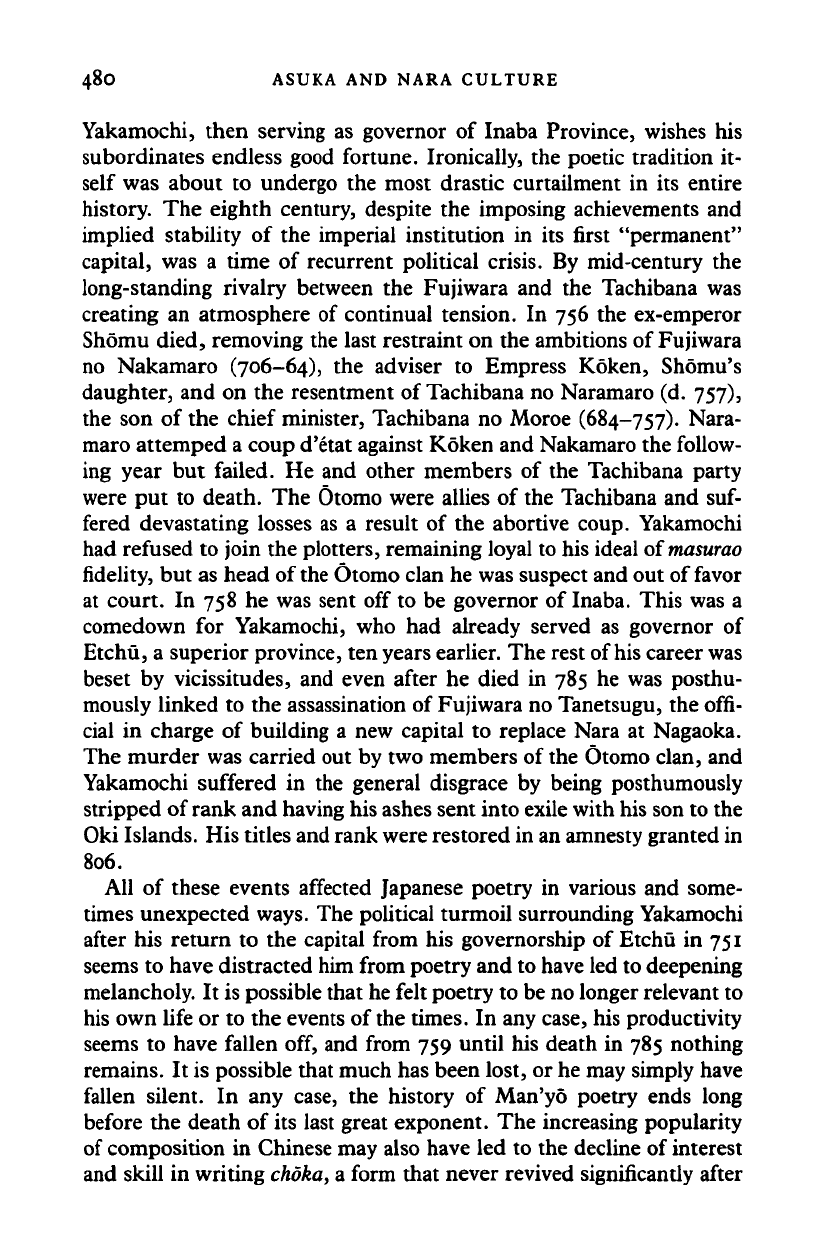
480 ASUKA AND NARA CULTURE
Yakamochi, then serving as governor of Inaba Province, wishes his
subordinates endless good fortune. Ironically, the poetic tradition it-
self was about to undergo the most drastic curtailment in its entire
history. The eighth century, despite the imposing achievements and
implied stability of the imperial institution in its first "permanent"
capital, was a time of recurrent political crisis. By mid-century the
long-standing rivalry between the Fujiwara and the Tachibana was
creating an atmosphere of continual tension. In 756 the ex-emperor
Shomu died, removing the last restraint on the ambitions of Fujiwara
no Nakamaro (706-64), the adviser to Empress Koken, Shomu's
daughter, and on the resentment of Tachibana no Naramaro (d. 757),
the son of the chief minister, Tachibana no Moroe (684-757). Nara-
maro attemped a coup d'etat against Koken and Nakamaro the follow-
ing year but failed. He and other members of the Tachibana party
were put to death. The Otomo were allies of the Tachibana and suf-
fered devastating losses as a result of the abortive coup. Yakamochi
had refused to join the plotters, remaining loyal to his ideal of
masurao
fidelity, but as head of
the
Otomo clan he was suspect and out of favor
at court. In 758 he was sent off to be governor of Inaba. This was a
comedown for Yakamochi, who had already served as governor of
Etchu, a superior province, ten years earlier. The rest of his career was
beset by vicissitudes, and even after he died in 785 he was posthu-
mously linked to the assassination of Fujiwara no Tanetsugu, the offi-
cial in charge of building a new capital to replace Nara at Nagaoka.
The murder was carried out by two members of the Otomo clan, and
Yakamochi suffered in the general disgrace by being posthumously
stripped of rank and having his ashes sent into exile with his son to the
Oki Islands. His titles and rank were restored in an amnesty granted in
806.
All of these events affected Japanese poetry in various and some-
times unexpected ways. The political turmoil surrounding Yakamochi
after his return to the capital from his governorship of Etchu in 751
seems to have distracted him from poetry and to have led to deepening
melancholy. It is possible that he felt poetry to be no longer relevant to
his own life or to the events of the times. In any case, his productivity
seems to have fallen off, and from 759 until his death in 785 nothing
remains. It is possible that much has been lost, or he may simply have
fallen silent. In any case, the history of Man'yo poetry ends long
before the death of its last great exponent. The increasing popularity
of composition in Chinese may also have led to the decline of interest
and skill in writing
choka,
a form that never revived significantly after
Cambridge Histories Online © Cambridge University Press, 2008
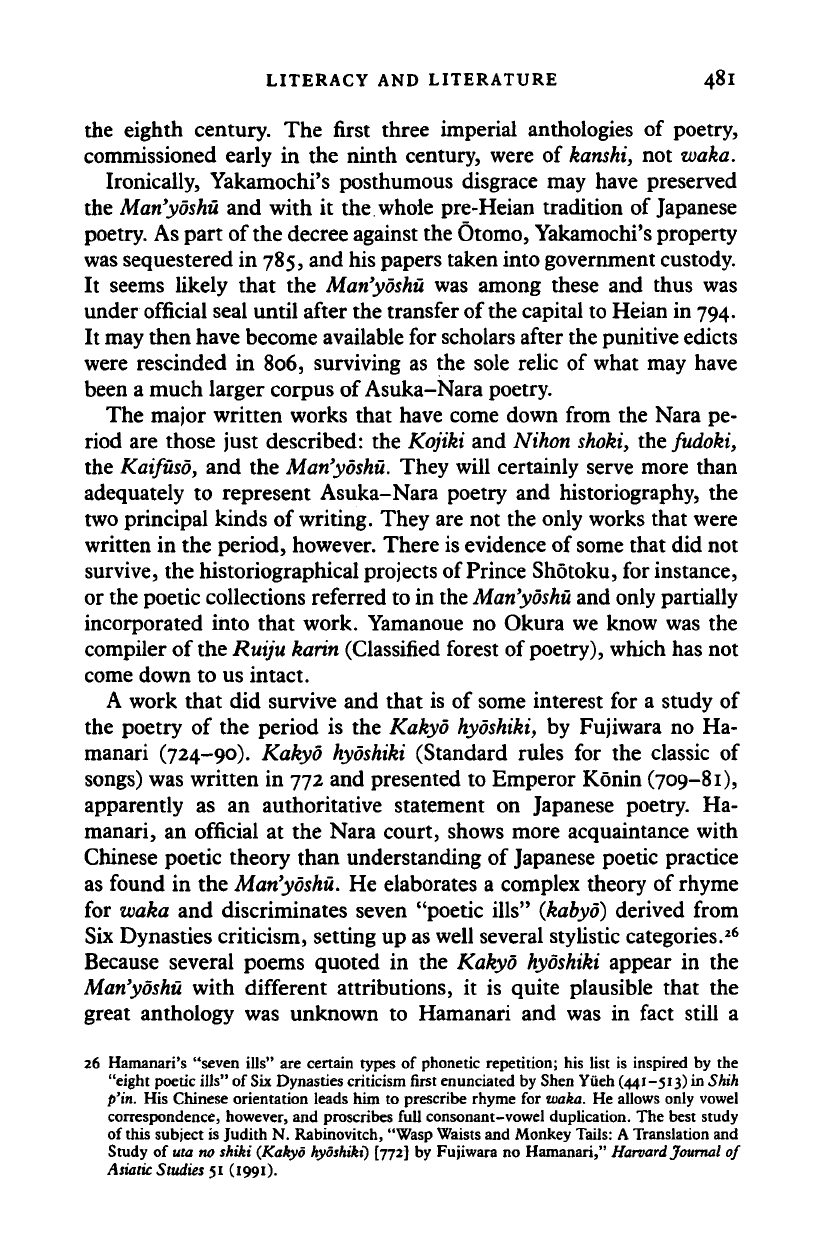
LITERACY AND LITERATURE 481
the eighth century. The first three imperial anthologies of poetry,
commissioned early in the ninth century, were of
kanshi,
not waka.
Ironically, Yakamochi's posthumous disgrace may have preserved
the
Man'yoshu
and with it the whole pre-Heian tradition of Japanese
poetry. As part of the decree against the Otomo, Yakamochi's property
was sequestered in
785,
and his papers taken into government custody.
It seems likely that the Man'yoshu was among these and thus was
under official seal until after the transfer of
the
capital to Heian in 794.
It may then have become available for scholars after the punitive edicts
were rescinded in 806, surviving as the sole relic of what may have
been a much larger corpus of Asuka-Nara poetry.
The major written works that have come down from the Nara pe-
riod are those just described: the Kojiki and Nihon
shoki,
the fudoki,
the Kaifuso, and the
Man'yoshu.
They will certainly serve more than
adequately to represent Asuka-Nara poetry and historiography, the
two principal kinds of
writing.
They are not the only works that were
written in the period, however. There is evidence of
some
that did not
survive, the historiographical projects of Prince Shotoku, for instance,
or the poetic collections referred to in the
Man'yoshu
and only partially
incorporated into that work. Yamanoue no Okura we know was the
compiler of the Ruiju
karin
(Classified forest of
poetry),
which has not
come down to us intact.
A work that did survive and that is of some interest for a study of
the poetry of the period is the Kakyo
hydshiki,
by Fujiwara no Ha-
manari (724-90). Kakyo hydshiki (Standard rules for the classic of
songs) was written in 772 and presented to Emperor Konin (709-81),
apparently as an authoritative statement on Japanese poetry. Ha-
manari, an official at the Nara court, shows more acquaintance with
Chinese poetic theory than understanding of Japanese poetic practice
as found in the
Man'yoshu.
He elaborates a complex theory of rhyme
for waka and discriminates seven "poetic ills" (kabyo) derived from
Six Dynasties criticism, setting up as well several stylistic categories.
26
Because several poems quoted in the Kakyo
hydshiki
appear in the
Man'yoshu with different attributions, it is quite plausible that the
great anthology was unknown to Hamanari and was in fact still a
26 Hamanari's "seven ills" are certain types of phonetic repetition; his list is inspired by the
"eight poetic ills" of Six Dynasties criticism first enunciated by Shen Yuen (441-513) in Shih
p'in.
His Chinese orientation leads him to prescribe rhyme for waka. He allows only vowel
correspondence, however, and proscribes full consonant-vowel duplication. The best study
of this subject is Judith N. Rabinovitch, "Wasp Waists and Monkey Tails: A Translation and
Study of uta no shiki (Kakyo hydshiki) [772] by Fujiwara no Hamanari," Harvard Journal of
Asiatic Studies 31 (1991).
Cambridge Histories Online © Cambridge University Press, 2008
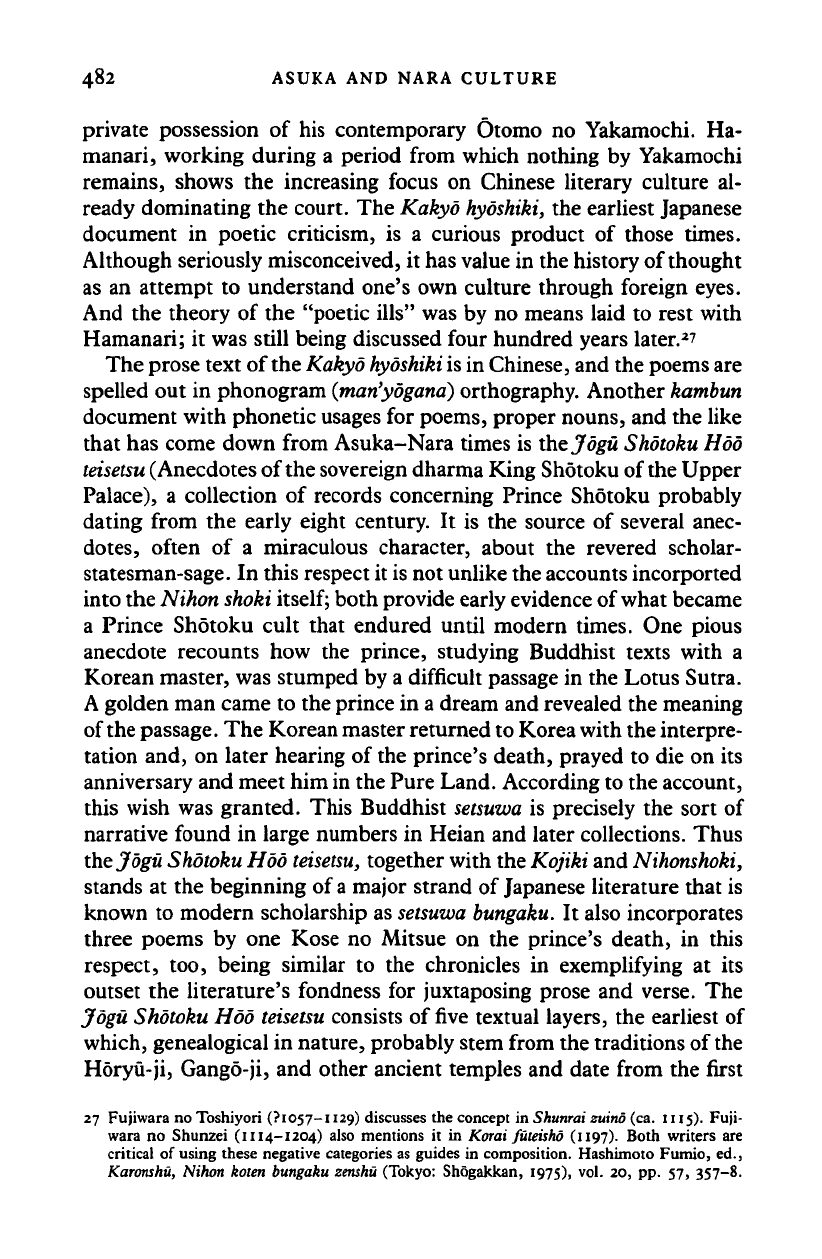
482 ASUKA AND NARA CULTURE
private possession of his contemporary Otomo no Yakamochi. Ha-
manari, working during a period from which nothing by Yakamochi
remains, shows the increasing focus on Chinese literary culture al-
ready dominating the court. The Kakyo
hydshiki,
the earliest Japanese
document in poetic criticism, is a curious product of those times.
Although seriously misconceived, it has value in the history of thought
as an attempt to understand one's own culture through foreign eyes.
And the theory of the "poetic ills" was by no means laid to rest with
Hamanari; it was still being discussed four hundred years later.
2
?
The prose text of the
Kakyo hydshiki is
in Chinese, and the poems are
spelled out in phonogram
(man'ydgana)
orthography. Another
kambun
document with phonetic usages for poems, proper nouns, and the like
that has come down from Asuka-Nara times is the Jdgu
Shotoku Hod
teisetsu
(Anecdotes of the sovereign dharma King Shotoku of the Upper
Palace), a collection of records concerning Prince Shotoku probably
dating from the early eight century. It is the source of several anec-
dotes,
often of a miraculous character, about the revered scholar-
statesman-sage. In this respect it is not unlike the accounts incorported
into the Nihon
shoki
itself;
both provide early evidence of what became
a Prince Shotoku cult that endured until modern times. One pious
anecdote recounts how the prince, studying Buddhist texts with a
Korean master, was stumped by a difficult passage in the Lotus Sutra.
A
golden man came to the prince in a dream and revealed the meaning
of the
passage.
The Korean master returned to Korea with the interpre-
tation and, on later hearing of the prince's death, prayed to die on its
anniversary and meet him in the Pure Land. According to the account,
this wish was granted. This Buddhist
setsuwa
is precisely the sort of
narrative found in large numbers in Heian and later collections. Thus
the Jdgu
Shotoku
Hod
teisetsu,
together with the Kojiki and
Nihonshoki,
stands at the beginning of
a
major strand of Japanese literature that is
known to modern scholarship as
setsuwa
bungaku.
It also incorporates
three poems by one Kose no Mitsue on the prince's death, in this
respect, too, being similar to the chronicles in exemplifying at its
outset the literature's fondness for juxtaposing prose and verse. The
Jdgu
Shotoku
Hod
teisetsu
consists of five textual layers, the earliest of
which, genealogical in nature, probably stem from the traditions of the
Horyu-ji, Gango-ji, and other ancient temples and date from the first
27 Fujiwara no Toshiyori (?K>57-i 129) discusses the concept in Shunrai zuino (ca. 1115). Fuji-
wara no Shunzei (1114-1204) also mentions it in Korai futeisho (1197). Both writers are
critical of using these negative categories as guides in composition. Hashimoto Fumio, ed.,
Karonshu, Nihon koten bungaku
zenshu
(Tokyo: Shogakkan, 1975), vol. 20, pp. 57, 357-8.
Cambridge Histories Online © Cambridge University Press, 2008
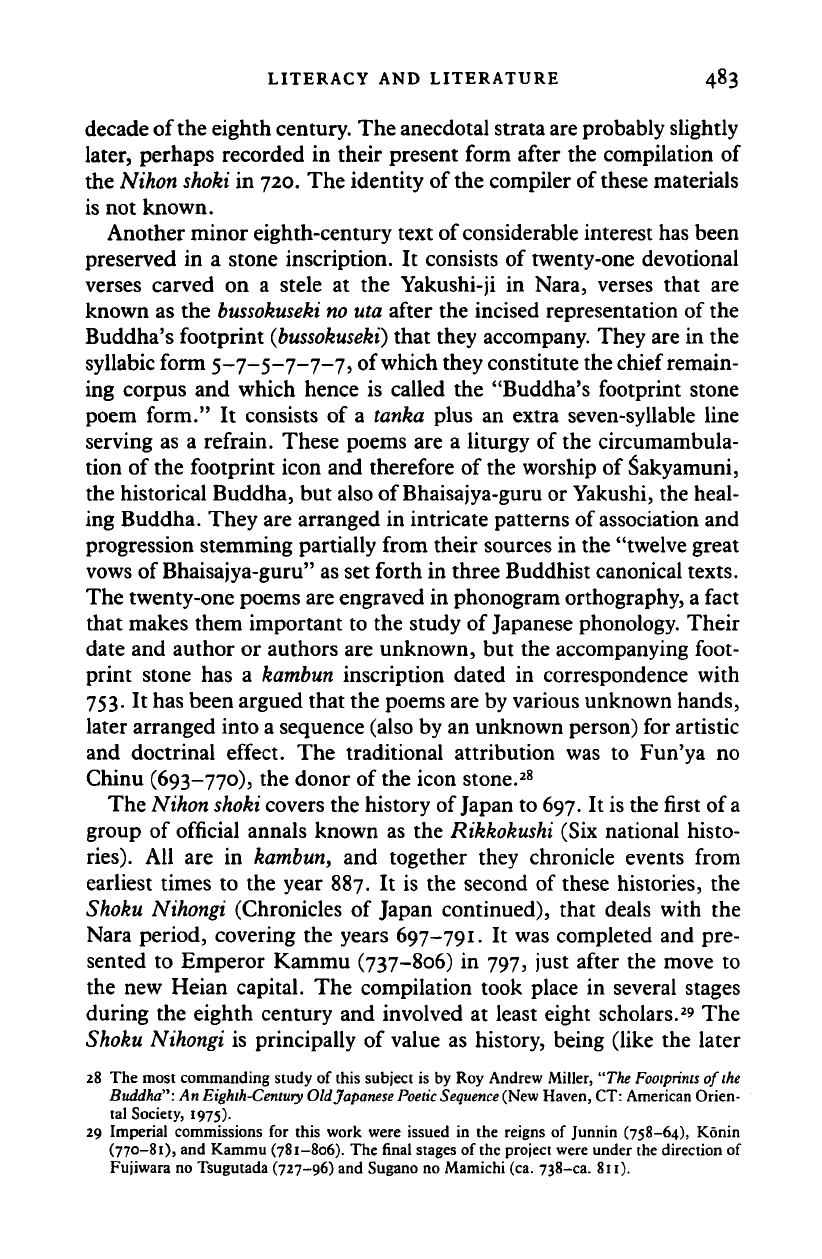
LITERACY AND LITERATURE 483
decade of the eighth century. The anecdotal strata are probably slightly
later, perhaps recorded in their present form after the compilation of
the Nihon
shoki
in 720. The identity of the compiler of these materials
is not known.
Another minor eighth-century text of considerable interest has been
preserved in a stone inscription. It consists of twenty-one devotional
verses carved on a stele at the Yakushi-ji in Nara, verses that are
known as the
bussokuseki no
uta after the incised representation of the
Buddha's footprint
(bussokuseki)
that they accompany. They are in the
syllabic form 5-7-5-7-7-7, of which they constitute the chief remain-
ing corpus and which hence is called the "Buddha's footprint stone
poem form." It consists of a tanka plus an extra seven-syllable line
serving as a refrain. These poems are a liturgy of the circumambula-
tion of the footprint icon and therefore of the worship of Sakyamuni,
the historical Buddha, but also of Bhaisajya-guru or Yakushi, the heal-
ing Buddha. They are arranged in intricate patterns of association and
progression stemming partially from their sources in the "twelve great
vows of Bhaisajya-guru" as set forth in three Buddhist canonical texts.
The twenty-one poems are engraved in phonogram orthography, a fact
that makes them important to the study of Japanese phonology. Their
date and author or authors are unknown, but the accompanying foot-
print stone has a kambun inscription dated in correspondence with
753.
It has been argued that the poems are by various unknown hands,
later arranged into a sequence (also by an unknown person) for artistic
and doctrinal effect. The traditional attribution was to Fun'ya no
Chinu (693-770), the donor of the icon stone.
28
The Nihon
shoki
covers the history of Japan to
697.
It is the first of
a
group of official annals known as the Rikkokushi (Six national histo-
ries).
All are in kambun, and together they chronicle events from
earliest times to the year 887. It is the second of these histories, the
Shoku Nihongi (Chronicles of Japan continued), that deals with the
Nara period, covering the years
697-791.
It was completed and pre-
sented to Emperor Kammu (737-806) in 797, just after the move to
the new Heian capital. The compilation took place in several stages
during the eighth century and involved at least eight scholars.
2
' The
Shoku Nihongi is principally of value as history, being (like the later
28 The most commanding study of this subject is by Roy Andrew Miller, "The
Footprints
of
the
Buddha": An Eighth-Century Old Japanese
Poetic
Sequence (New Haven, CT: American Orien-
tal Society, 1975).
29 Imperial commissions for this work were issued in the reigns of Junnin (758-64), Konin
(770-81), and Kammu (781-806). The final stages of the project were under the direction of
Fujiwara no Tsugutada (727-96) and Sugano no Mamichi (ca. 738-ca. 811).
Cambridge Histories Online © Cambridge University Press, 2008
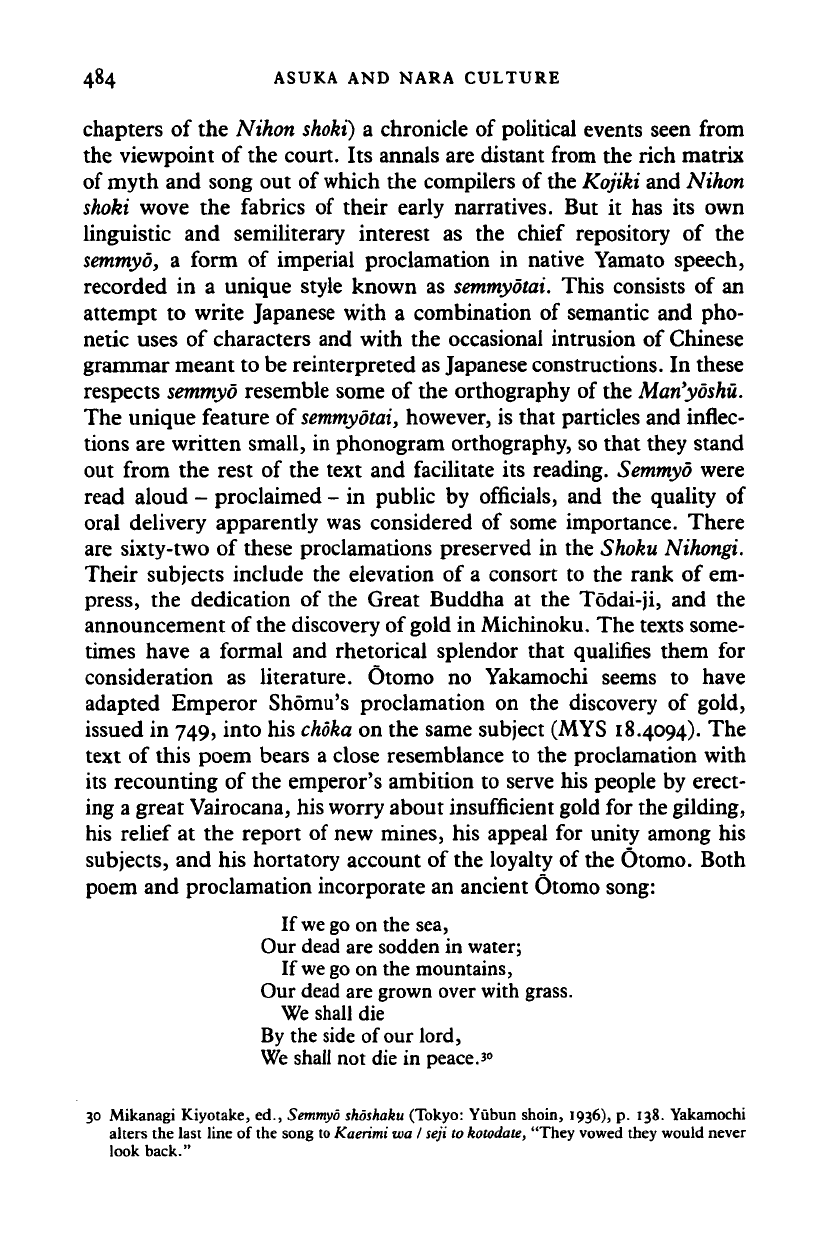
484 ASUKA AND NARA CULTURE
chapters of the Nihon
shoki)
a chronicle of political events seen from
the viewpoint of the court. Its annals are distant from the rich matrix
of myth and song out of which the compilers of the Kojiki and Nihon
shoki wove the fabrics of their early narratives. But it has its own
linguistic and semiliterary interest as the chief repository of the
semmyo, a form of imperial proclamation in native Yamato speech,
recorded in a unique style known as
semmyotai.
This consists of an
attempt to write Japanese with a combination of semantic and pho-
netic uses of characters and with the occasional intrusion of Chinese
grammar meant to be reinterpreted as Japanese constructions. In these
respects
semmyo
resemble some of the orthography of the
Man'yoshu.
The unique feature of
semmyotai,
however, is that particles and inflec-
tions are written small, in phonogram orthography, so that they stand
out from the rest of the text and facilitate its reading.
Semmyo
were
read aloud - proclaimed - in public by officials, and the quality of
oral delivery apparently was considered of some importance. There
are sixty-two of these proclamations preserved in the Shoku Nihongi.
Their subjects include the elevation of a consort to the rank of em-
press,
the dedication of the Great Buddha at the Todai-ji, and the
announcement of the discovery of gold in Michinoku. The texts some-
times have a formal and rhetorical splendor that qualifies them for
consideration as literature. Otomo no Yakamochi seems to have
adapted Emperor Shomu's proclamation on the discovery of gold,
issued in 749, into his
choka
on the same subject (MYS 18.4094). The
text of this poem bears a close resemblance to the proclamation with
its recounting of the emperor's ambition to serve his people by erect-
ing a great Vairocana, his worry about insufficient gold for the gilding,
his relief at the report of new mines, his appeal for unity among his
subjects, and his hortatory account of the loyalty of the Otomo. Both
poem and proclamation incorporate an ancient Otomo song:
If
we go
on the sea,
Our dead are sodden in water;
If
we go
on the mountains,
Our dead are grown over with grass.
We shall die
By the side of our lord,
We shall not die in peace.'
0
30 Mikanagi Kiyotake, ed.,
Semmyo shoshaku
(Tokyo: Yubun shoin, 1936), p. 138. Yakamochi
alters the last line of the song to Kaerimi wa
I
seji to kotodate, "They vowed they would never
look back."
Cambridge Histories Online © Cambridge University Press, 2008
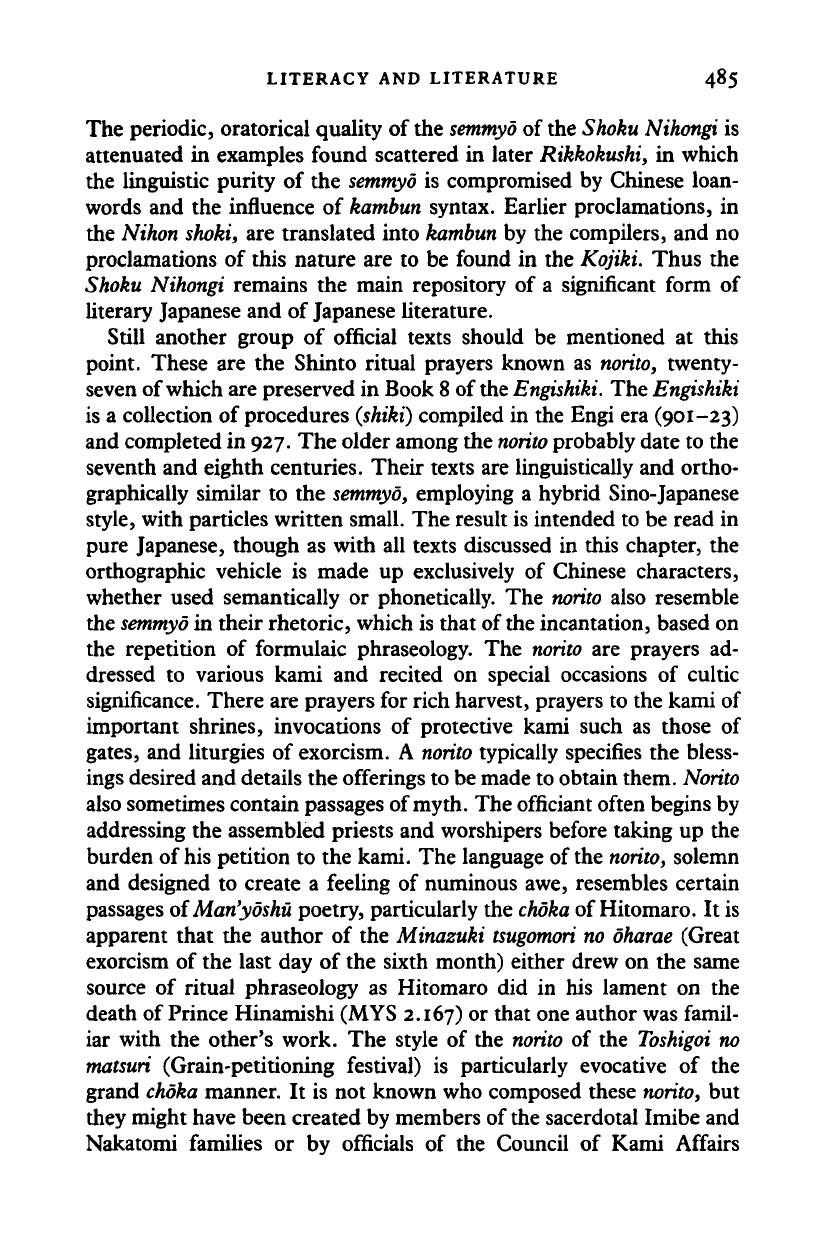
LITERACY AND LITERATURE 485
The periodic, oratorical quality of the
semmyo
of the Shoku
Nihongi
is
attenuated in examples found scattered in later Rikkokushi, in which
the linguistic purity of the
semmyo
is compromised by Chinese loan-
words and the influence of
kambun
syntax. Earlier proclamations, in
the Nikon
shoki,
are translated into
kambun
by the compilers, and no
proclamations of this nature are to be found in the Kojiki. Thus the
Shoku Nihongi remains the main repository of a significant form of
literary Japanese and of Japanese literature.
Still another group of official texts should be mentioned at this
point. These are the Shinto ritual prayers known as
norito,
twenty-
seven of which are preserved in Book
8
of
the
Engishiki.
The
Engishiki
is a collection of procedures
(shiki)
compiled in the Engi era (901-23)
and completed in
927.
The older among the
norito
probably date to the
seventh and eighth centuries. Their texts are linguistically and ortho-
graphically similar to the
semmyo,
employing a hybrid Sino-Japanese
style,
with particles written small. The result is intended to be read in
pure Japanese, though as with all texts discussed in this chapter, the
orthographic vehicle is made up exclusively of Chinese characters,
whether used semantically or phonetically. The
norito
also resemble
the
semmyo
in their rhetoric, which is that of
the
incantation, based on
the repetition of formulaic phraseology. The
norito
are prayers ad-
dressed to various kami and recited on special occasions of cultic
significance. There are prayers for rich harvest, prayers to the kami of
important shrines, invocations of protective kami such as those of
gates,
and liturgies of exorcism. A
norito
typically specifies the bless-
ings desired and details the offerings to be made to obtain them.
Norito
also sometimes contain passages of myth. The officiant often begins by
addressing the assembled priests and worshipers before taking up the
burden of
his
petition to the kami. The language of the
norito,
solemn
and designed to create a feeling of numinous awe, resembles certain
passages of
Man'yoshu
poetry, particularly the
chdka
of
Hitomaro.
It is
apparent that the author of the Minazuki
tsugomori
no
dharae
(Great
exorcism of the last day of the sixth month) either drew on the same
source of ritual phraseology as Hitomaro did in his lament on the
death of Prince Hinamishi (MYS 2.167) or that one author was famil-
iar with the other's work. The style of the
norito
of the
Toshigoi
no
matsuri (Grain-petitioning festival) is particularly evocative of the
grand
chdka
manner. It is not known who composed these
norito,
but
they might have been created by members of
the
sacerdotal Imibe and
Nakatomi families or by officials of the Council of Kami Affairs
Cambridge Histories Online © Cambridge University Press, 2008
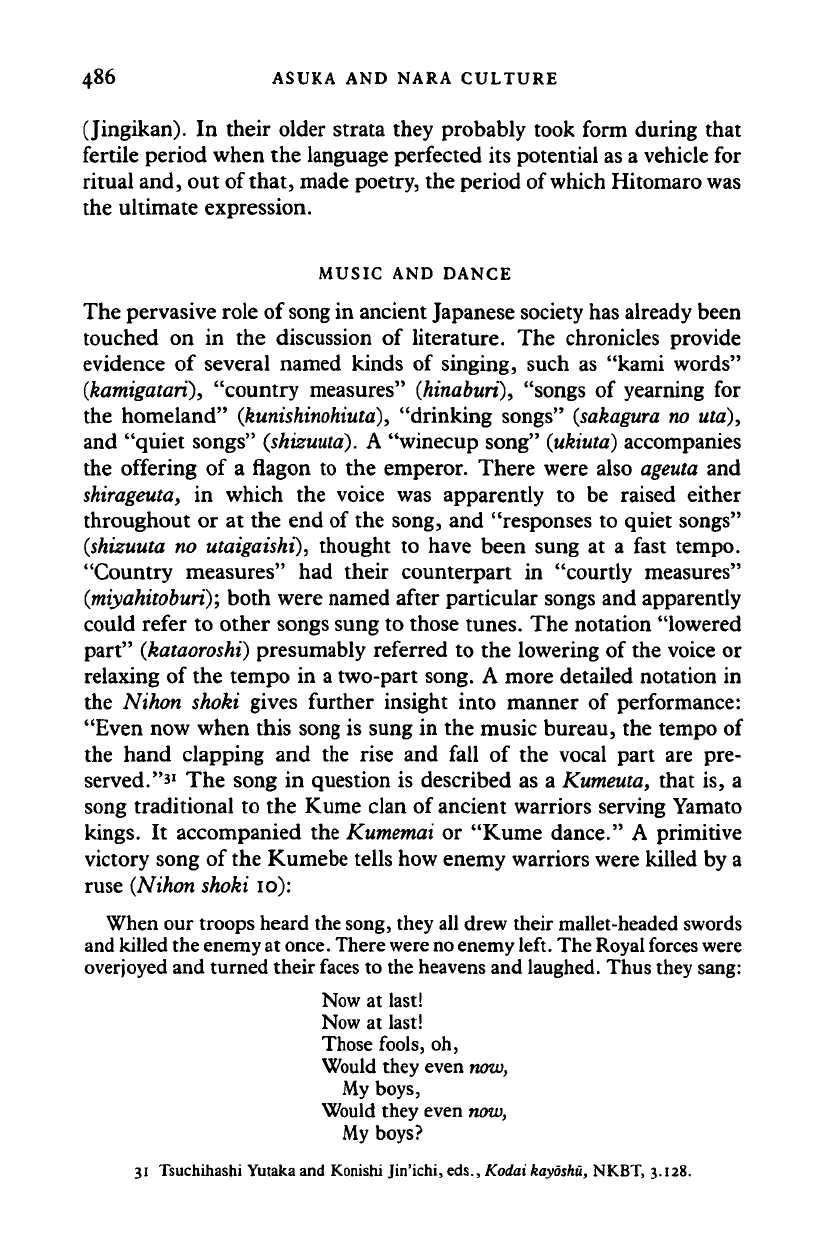
486 ASUKA AND NARA CULTURE
(Jingikan). In their older strata they probably took form during that
fertile period when the language perfected its potential as a vehicle for
ritual and, out of that, made poetry, the period of which Hitomaro was
the ultimate expression.
MUSIC AND DANCE
The pervasive role of
song
in ancient Japanese society has already been
touched on in the discussion of literature. The chronicles provide
evidence of several named kinds of singing, such as "kami words"
(kamigatari), "country measures" (hinaburi), "songs of yearning for
the homeland"
(kunishinohiuta),
"drinking songs"
(sakagura
no uta),
and "quiet songs"
(shizuuta).
A "winecup song"
(ukiuta)
accompanies
the offering of a flagon to the emperor. There were also
ageuta
and
shirageuta, in which the voice was apparently to be raised either
throughout or at the end of the song, and "responses to quiet songs"
(shizuuta no
utaigaishi),
thought to have been sung at a fast tempo.
"Country measures" had their counterpart in "courtly measures"
(miyahitoburi);
both were named after particular songs and apparently
could refer to other songs sung to those tunes. The notation "lowered
part"
(kataoroshi)
presumably referred to the lowering of the voice or
relaxing of the tempo in a two-part song. A more detailed notation in
the Nihon shoki gives further insight into manner of performance:
"Even now when this song is sung in the music bureau, the tempo of
the hand clapping and the rise and fall of the vocal part are pre-
served."
31
The song in question is described as a
Kumeuta,
that is, a
song traditional to the Kume clan of ancient warriors serving Yamato
kings.
It accompanied the
Kumemai
or "Kume dance." A primitive
victory song of the Kumebe tells how enemy warriors were killed by a
ruse (Nihon shoki 10):
When our troops heard the song, they all drew their mallet-headed swords
and killed the enemy at
once.
There
were no
enemy left. The Royal forces were
overjoyed and turned their faces to the heavens and laughed. Thus they sang:
Now at last!
Now at last!
Those fools, oh,
Would they even now,
My boys,
Would they even now,
My boys?
31 Tsuchihashi Yutaka and Konishi Jin'ichi, eds.,
Kodai
kayoshu,
NKBT, 3.128.
Cambridge Histories Online © Cambridge University Press, 2008
